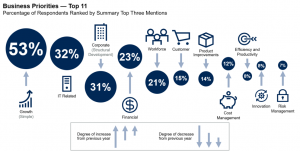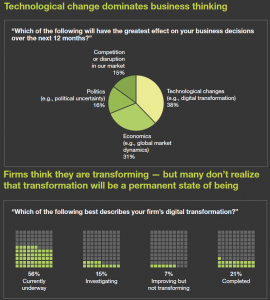Digital Transformation Journeys are Unique to Each Company
Since Digital Transformation is so broad, delving into how it can help companies requires the process to be broken down to its stages. For companies starting the process of digital transformation, often the questions that need answering are:
- Where and how do we start?
- How do we prioritize what needs to be done?
- What is the end game or objective?
- What is management expecting?
- What is the ‘right’ answer?
As a recent Gartner study suggests in Figure 1.1, CEO priorities remain driving growth, servicing customers better, and making their businesses operate more efficiently. Digital Transformation is a tool to achieve CEO priorities. Digital Transformation in and of itself is not the objective.
 Fig 1.1, Source: Gartner, 2019
Fig 1.1, Source: Gartner, 2019
There are many models for driving digital transformation and no single method is best for all companies or all situations. It is important for organizations to invest in a model that aligns with their strategic goals and vision as well as their technical capabilities.
- Some companies begin the process of digital transformation with digitalization. This entails digitizing existing paper documents, organizing the documents in a digital repository and replacing existing paper-based-processes with digital processes. This method does not change what gets done – it simply moves a paper-based workflow to a technology based one.
- Some companies, larger ones in particular, start by defining a digital strategy and vision. Here, companies invest in a long-term strategy, often lasting up to five years, with milestones and checks and balances along the way. This strategy transforms how data is managed and accessed, how technology, specifically machine learning, can augment everyday work and how deploying automation can reduce the manual handling of simple tasks or a series of more complex tasks.
- Other companies start by looking at digital fits. They start with current processes and workflows and identify areas where tasks can be automated or software can replace or supplement existing processes. Here, while many tasks are being routinely automated, innovating on the workflows or processes is often not part of the scope.
A key idea to note is that digital transformation is comprised of business process, business model, domain, and cultural/organizational changes. Digital Transformation is as much about morphing an organization to be more adept and able to innovate as it is about adopting emerging technologies to replace how work is currently done. The underlying goal of technology is to make processes more efficient and employees more productive.
As evidenced from a Gartner study in Figure 1.2, companies are all over the map in their digital journeys. It’s important to get started and define a journey that is right and unique for each organization, knowing that each business has a different starting point.
 Fig 1.2, Source: Gartner, 2019
Fig 1.2, Source: Gartner, 2019
There is no single strategy or process for digital transformation that fits every company or situation. It’s important that business objectives for any transformation are clearly defined. Companies should remain practical through their journey and realize that while large scale transformations can take years, they need to be productive and efficient along the entire journey.
This blog contains excerpts of an AAPL article written by Rakhee Das.
Rakhee Das, Innovation & Technology Practice Leader – Sirius Solutions, L.L.L.P.
If you would like further information regarding Digital Transformation, please complete the form below.
Error: Contact form not found.
